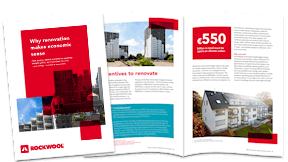Did you know that energy efficiency renovation is one of the highest impact economic recovery measures to secure local jobs while contributing to achieving climate goals and building a more resilient and healthier society?

Why building renovation is one of the cheapest COVID-19 recovery options to secure local jobs and reach our climate goals
Download the whitepaperDid you know that energy efficiency renovation is one of the highest impact economic recovery measures to secure local jobs while contributing to achieving climate goals and building a more resilient and healthier society?

Keep in mind, compared to other North American industries, construction is labour-intensive and locally-based. Around 95 percent of construction companies employ 10 or fewer people, and craftsmen generate two-thirds of their revenue locally, within a 30 mile, 50-km radius of their business[1]. Around 80 percent of value-added in the construction industry is created through SMEs. This means that a home improvement project boosts an industry in need – and instantly supports jobs in the local community. Also, since renovation projects often gain approval quickly and since there are so many buildings that can be improved, these jobs can be secured here-and-now.
As a matter of fact, channelling economic recovery funds specifically to energy efficiency renovation in buildings will support local jobs here and now. For every $1 million invested in renovation 18 local jobs are secured according to a BPIE study[2].
A billion dollars spent on construction generates 24,000 full-time jobs for 1 year, most of them in supporting industries, according to studies of 13 activities covering over half the value of new construction/ [3]
The clear message here is that investing in the energy renovation of our building stock is a no regret solution and a very rewarding choice. It brings personal benefits, societal benefits and economic benefits. In other words, an increase in renovations would have a direct impact on employment in all member states.

Energy renovation is the best way to achieve post COVID-19 economic growth while addressing the climate crisis. Learn how energy renovation can benefit society and the environment for a greener, more sustainable future.
The Unites States and Canada sees energy efficiency renovations for North America's building stock as one of the best ways to help our economies recover post COVID-19.
A transformative approach in our economic and social systems is needed and the buildings sector plays a crucial role in this transition and the planned Renovation Wave must become an engine of North America’s economic recovery plan.
In addition, investing in energy efficiency renovations ultimately reduces energy use, making it a very tempting investment. Based on a renovation of medium depth, the internal rate of return (IRR) over 30 years is 5-6% – and this is enticing for both home-owners and institutional investors. On average, investment in building renovation delivers more than two-fold return in energy cost savings over the lifetime of the investment[4].
Furthermore, the analysis shows that investing in building renovation can have additional benefits on public budgets, like increasing revenues from income taxation, corporate taxation and VAT, reduced expenditures linked to unemployment benefits, and lower direct and indirect health costs.

From pricing a typical renovation to exploring available grants, we strip down the costs – and savings – involved in renovation

Residential energy use accounts for roughly 20% of greenhouse gas (GHG) emissions in the United States. [7]
Thus, energy renovating and upgrading our urban landscape have huge and long-lasting environmental effects. As a matter of fact, the operational carbon of buildings – CO2 emissions throughout the life of a building – presently account for around 30 percent of the world’s CO2 emissions.
Worldwide, building renovation provides the most cost-effective method to reduce emissions when compared to other routes such as solar energy or fuel-efficient vehicles, with a $200M marginal cost per ton of CO2 emissions. Across the board, saving 1kWh of energy through stone wool insulation results in 480 and 220 times less carbon emissions than generating that same 1kWh from coal and gas respectively.
The “trickle-down” nature of these cost savings to consumers will help governments create long-term economic and environmental resilience, with substantial energy savings. With retrofitted buildings delivering household energy savings of $34 per square metre[5].
are created
needs to be spent on climate-related investments
of total primary energy demand and greenhouse gas emissions
Sources:
[1] Source: European Commission (2016)
[2] BPIE https://www.renovate-europe.eu/2020/06/10/building-renovation-a-kick-starter-for-the-eu-economy-2
[3] https://www.consilium.europa.eu/media/45109/210720-euco-final-conclusions-en.pdf
[4] The renovation depth logic is based on primary energy savings, considering 3-30% as light renovation, 30-60% as medium renovation and >60% as deep renovation. The yearly energy savings discounted for 30 years, assuming an average energy price of €0.15. Source: European commission (2019)
[5] Average European energy price: 0.2159€/kWh. Source European Commission (2019); Eurostat
Our products are diverse and contribute to shaping a circular economy, enhancing resource efficiency, and nurturing the safety, health and wellbeing of people.